What if, in addition to the record floods of 2009 and 2013 and 2014
apparently caused by local lack of planning in our watersheds,
what if we got 15 inches of rain in one 24 hour period like
Pensacola did a few weeks ago?
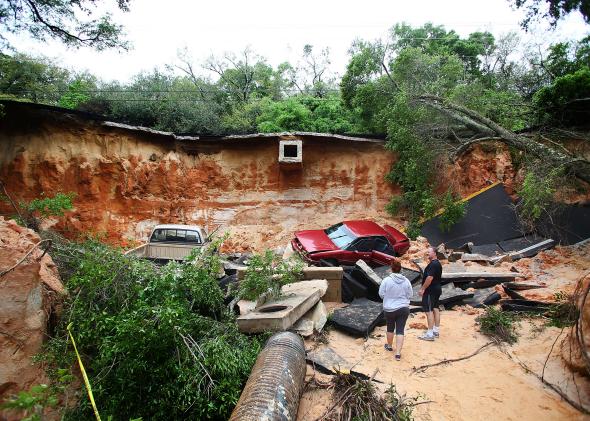 Local governments might get sued by insurers for lack of planning,
like 200 communities in the Chicago area already got sued.
Maybe we should plan ahead for greater weather variability
caused by climate change.
Local governments might get sued by insurers for lack of planning,
like 200 communities in the Chicago area already got sued.
Maybe we should plan ahead for greater weather variability
caused by climate change.
Eric Holthaus wrote for Future Tense on Slate 30 April 2014, The Calamitous Climate Responsible for Florida’s Record Rainfall,
Farmers Insurance, a major company you probably know from its commercials featuring J.K. Simmons explaining how “what you don’t know can hurt you,”
filed nine class action lawsuits last month against nearly 200 communities in the Chicago area. The company argues that the communities failed to prepare for heavy rain and floodwaters, despite dire warnings from researchers and numerous reports from the US government and the UN that climate change is bringing increasingly severe weather. Reuters’ Mica Rosenberg reports that the suits are the first of their kind.
The legal debate may center on whether an uptick in natural disasters is foreseeable or an “act of God.” The cases raise the question of how city governments should manage their budgets before costly emergencies occur.
“We will see more and more cases,” said Michael Gerrard, director of the Center for Climate Change Law at Columbia Law School in New York. “No one is expected to plan for the 500-year storm, but if horrible events are happening with increasing frequency, that may shift the duties.”
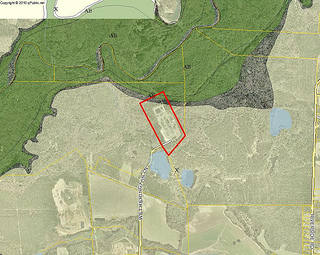 Actually, around here we are preparing for what used to be
700-year flooding to happen every 15-35 years, with smaller
flooding already having happened four years after the
record 2009 flood.
Now much of that isn’t exactly climate change;
it’s probably mostly a combination of too much clear-cutting,
development of buildings and parking lots and roads with
impermeable surfaces, invasive species changing hydrology,
and agricultural runoff, not to mention local governments
permitting development in flood plains.
Actually, around here we are preparing for what used to be
700-year flooding to happen every 15-35 years, with smaller
flooding already having happened four years after the
record 2009 flood.
Now much of that isn’t exactly climate change;
it’s probably mostly a combination of too much clear-cutting,
development of buildings and parking lots and roads with
impermeable surfaces, invasive species changing hydrology,
and agricultural runoff, not to mention local governments
permitting development in flood plains.
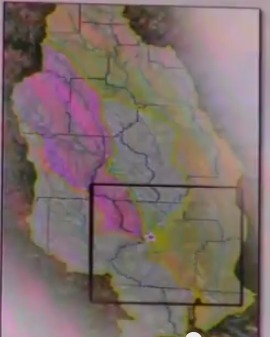 Now what if a storm like the one that dropped 5.68 inches in an hour
and 15.55 inches in 24 hours moved about 250 miles to the east
and dropped even part of that on Valdosta and Lowndes County.
Remember, we’re only about 70 miles from the Gulf at Alapachee Bay.
And what if it followed the usual sort of storm path and dumped
much of that upstream from here?
As Valdosta is fond of reminding us, and as
David Apple of the Corps pointed also said:
Now what if a storm like the one that dropped 5.68 inches in an hour
and 15.55 inches in 24 hours moved about 250 miles to the east
and dropped even part of that on Valdosta and Lowndes County.
Remember, we’re only about 70 miles from the Gulf at Alapachee Bay.
And what if it followed the usual sort of storm path and dumped
much of that upstream from here?
As Valdosta is fond of reminding us, and as
David Apple of the Corps pointed also said:
“Valdosta is at the bottom of a 1,500-square-mile drainage basin.”
A drainage basin that usually gets weather from the Gulf straight from Pensacola:
Looking upstream, on the Little River near Adel, we’ve already seen the second highest recorded water level ever recorded 26 February 2013 at 21.02 feet, only lower than the 22.35 feet 3 April 2009, and higher than the 21-foot records in 1986 and 1948.
The
Little River at GA 122 peaked the next day; we don’t know how that
compared to 2009 or earlier, because, to their credit,
the Lowndes County Commission funded that gage after the flood of 2009.
However, on
the Withlacoochee River at McMillan road near Bemiss
a peak of 21.78 feet two days later on 28 February 2014 was only exceeded by
peaks of 22.44 in 1991, 22.50 in 1998, and 25.66 in 4 April 2009.
At the closest gage to the often-overflowing Withlacoochee Wastewater Treatment Plant, on the Withlacoochee River at US 84, the 1 March 2013 peak of 31.48 was exceeded by the 1948 peak of 31.70 feet, yet the 5 April 2009 peak of 34.67 feet was amost three feet higher than that.
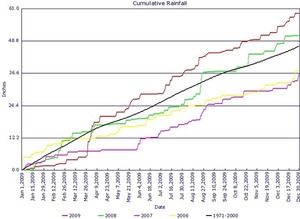 And that 2009 event,
while
quite rainy, was not a record rainfall.
What if we did get a record rainfall?
And that 2009 event,
while
quite rainy, was not a record rainfall.
What if we did get a record rainfall?
According to the EPA’s Climate Change Indicators in the United States,
In recent years, a larger percentage of precipitation has come in the form of intense single-day events. Eight of the top 10 years for extreme one-day precipitation events have occurred since 1990 (see Figure 1).
As Eric Holthaus explained:
Climate change is playing a role in extreme rainfall events like the one on Tuesday. The science is here is relatively straightforward: As the atmosphere warms, it can hold more water vapor. You can see this effect for yourself on muggy summer days when droplets of condensation form on the windows of air-conditioned buildings. There’s now more moisture available that can turn into rain. Warmer days lead to more evaporation, and more evaporation leads to heavier rainfall.
And that heavier rainfall is more likely to happen, with more droughts in between.
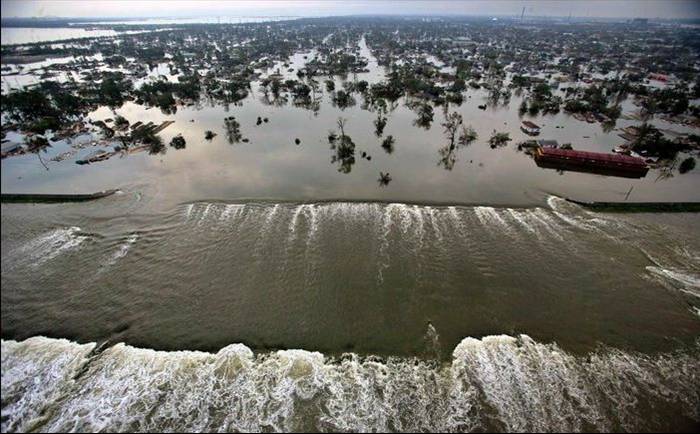 This is why
building a levee where Sugar Creek joins the Withlacoochee River
isn’t a solution.
We don’t even know how bad the problem is.
The Corps allowed 3 feet of freeboard from their highest Withlacoochee
flood prediction to the top of the levee.
We already saw that three feet water level difference between 1948 and 2009.
What if the Corps is wrong, and the neighborhoods around Sugar Creek flood like
the Ninth Ward of New Orleans during Hurricane Katrina?
Lawsuits flew about that one.
This is why
building a levee where Sugar Creek joins the Withlacoochee River
isn’t a solution.
We don’t even know how bad the problem is.
The Corps allowed 3 feet of freeboard from their highest Withlacoochee
flood prediction to the top of the levee.
We already saw that three feet water level difference between 1948 and 2009.
What if the Corps is wrong, and the neighborhoods around Sugar Creek flood like
the Ninth Ward of New Orleans during Hurricane Katrina?
Lawsuits flew about that one.
 And in a flood that bad, what about the rest our watersheds?
And in a flood that bad, what about the rest our watersheds?
The Corps never once mentioned record rainfalls or climate change during its two presentations May 6th. While I commend the Corps on doing the initial study and Valdosta on funding it, I commend the Corps more for wanting to do the followon watershed-wide study:
This report established that there could be Federal interest in pursuing future flood management risk studies under other USACE authorities.
And of course it’s also good that Valdosta has funded and is implementing plans for a force main and to move the Withlacoochee Wastewater Treatment Plant uphill.
 In addition to all that, as
Council Tim Carrol said, we need to
In addition to all that, as
Council Tim Carrol said, we need to
Engage congressional leaders, secure funding and find long term, sustainable solutions that benefit all communities within the watershed basin. A levee by itself is not the answer.
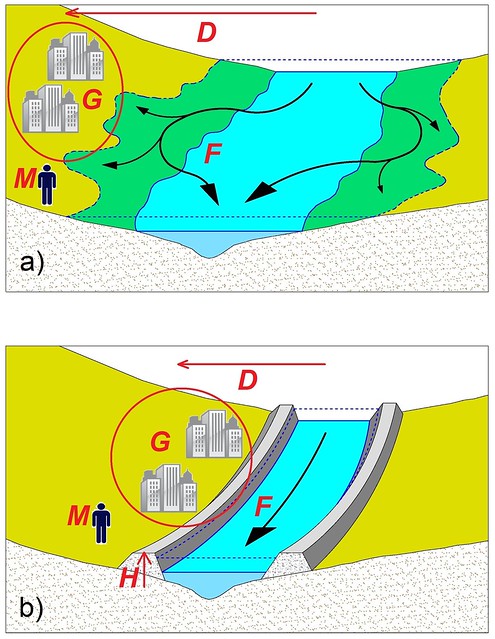 A levee could even
encourage settling too close
due to a false sense of security.
A levee could even
encourage settling too close
due to a false sense of security.
Planning ahead would be prudent, to avoid lawsuits from insurers. Not to mention to prepare and maybe prevent property damage and loss of life from future flooding.
-jsq
Short Link:
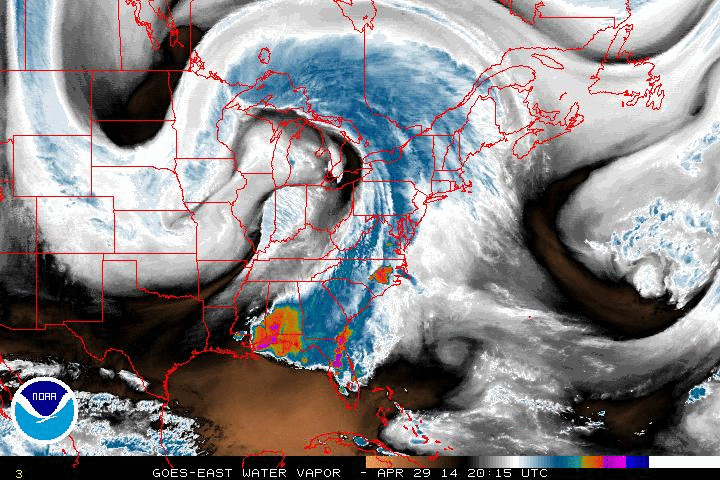

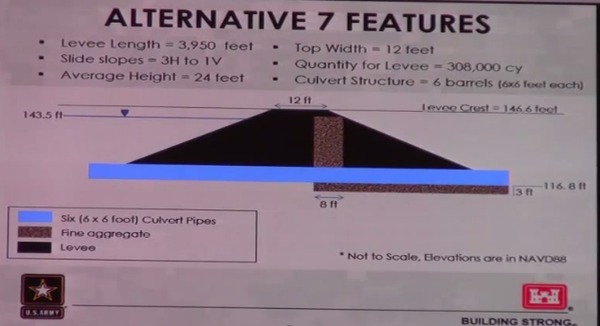
Pingback: Methane explosion in Escambia County Jail in Pensacola, FL | SpectraBusters